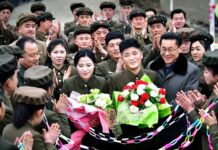The conversion of the Sungho-ri Political Prison Camp in North Hwanghae Province into a forced labor camp for cadres was a measure to avoid the watchful eye of the international community, Daily NK has learned.
The authorities converted the facility because unlike other political prison camps located deep in the mountains, the Sungho-ri camp is located near a residential area, making it hard to prevent information about it from leaking outside the country.
A source in North Korea told Daily NK on Thursday that the authorities converted the camp because they could not thoroughly isolate it from society. The camp’s surrounding areas render it impossible to secretly garrison like other political prison camps.
For example, the Mandalsan Cement Factory and its workers’ homes are located near the site, which does not lend itself to the kind of strict secrecy needed to avoid international surveillance. As a result, the authorities converted the facility from a political prison camp into a labor camp after a government review process, according to the source.
Daily NK reported in early August that the Sungho-ri Political Prison Camp, which was built in 2020, was converted into a detention facility for high-ranking cadres and officials who handled confidential information in their work.
The international community pays close attention to North Korea’s political prison camps as they are considered the prime areas of human rights abuse in the country. North Korea denies the very existence of the camps, shrouding them in strict secrecy.
Besides the recently converted Sungho-ri camp, seven political prison camps exist in North Korea. Unlike most of those camps, which are located deep in the mountains, the Sungho-ri camp is located in a relatively open area. As such, North Korea appears to have judged that there was a risk of information about the camp leaking to the outside world, including its location.
The source said that with the conversion of the political prison camp into a forced labor camp, the intensity of the work forced upon its prisoners has lessened.
“Punitive tasks have eased, in contrast to when it was a political prison camp, and regulations regarding the intensity of punitive labor have grown more lax, too,” he said.
“The head of the camp, the prison guards and the sentries are all the same, so prison management remains intense and harsh,” he said. “But they generally allow visits, and since they also accept bribes, camp management sometimes treat prisoners well.”
The Sungho-ri camp now holds cadres who were arrested for involvement in various incidents, the source said.
Based on his report, high-ranking cadres in the camp come from the Ministry of the Electric Power Industry, Ministry of State Natural Resources Development, Ministry of Railways, Ministry of External Economic Relations, and the country’s Central Bank. Prisoners who worked at secret facilities include civilian designers who designed underground tunnels at strategic weapon bases in Chagang Province, as well as other special districts of the country.
The family members of these cadres and other prisoners are also confined at the camp, the source said.
When high-ranking prisoners enter the camp, administrators reportedly decide how to treat them after examining their case documents and determining how likely it is they could rejoin society.
Administrators treat prisoners depending on who they are, treating even high-ranking cadres cruelly if they have little chance of rejoining society, while taking care of those likely to be rehabilitated, the source added.
Please direct any comments or questions about this article to dailynkenglish@uni-media.net.



















